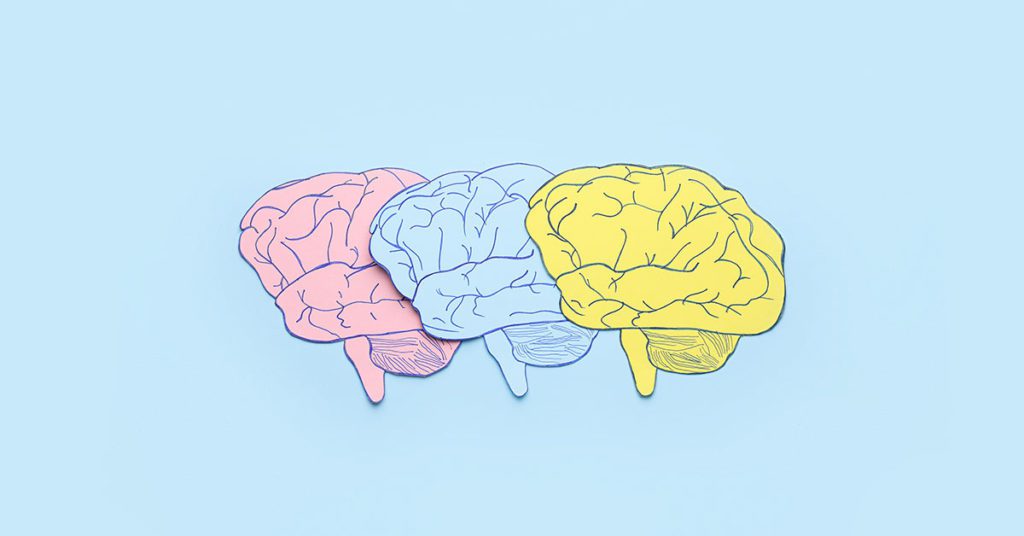The brain is a dynamic, flexible system. It can change and rewire itself—a concept known as neuroplasticity. You can literally change your mind by redirecting the neural pathways in the brain. Discover more about neuroplasticity and how to support your brain’s ability to heal, learn, and grow at any stage of life.
Neuroplasticity Definition
Neuroplasticity is the brain’s ability to change and adapt in both structure and function throughout life and in response to experience.
Benefits of Neuroplasticity
- It allows our brains to adapt to new situations and environments.
- It helps heal from brain trauma, stroke, or injury.
- It allows the brain to function more efficiently.
- It enables us to learn new skills.
Up until the 1960s, neuroscientists believed that the changes in the brain only happened during infancy and childhood. They thought that the brain’s physical structure became permanent in adulthood.
Modern science and technology have enabled us to observe the brain unlike ever before. Tools, like Functional Magnetic Resonance Imaging (fMRI) or electroencephalography (EEG), display activity and changes in brain structure and function. Observing activity in the brain and how it changes under certain conditions over time has revealed the remarkable ability of the brain to grow and reorganize its neural pathways.
Neural Pathways in the Brain
The brain consists of billions of nerve cells, called neurons. They communicate with each other by sending signals from one neuron to the other along neural pathways.
During the first few years of a baby’s life, the brain forms neural pathways rapidly. At birth, a baby has an average of 2,500 synapses, the area where nerves relay messages. By age three, this number grows to over 15,000 synapses per neuron!
By adulthood, the brain has about half of the number of synapses. That’s because as adults, the brain goes through a process called neural pruning. It strengthens neural pathways used frequently while eliminating others. By developing new connections and pruning away less important ones, the brain can adapt to the changing environment and work more efficiently.
The neural pathways in the brain work a little bit like a dirt path. During the early years of development, neurons begin to send and receive signals. These back-and-forth signals act like a truck over a dirt road: as they repeat, they pave deeper pathways making it easier and easier for signals to travel back and forth.
Have you ever heard that phrase, “You can’t teach an old dog new tricks?”
Well, think again.
Neuroplasticity is a lifelong process. It begins rapidly as infants learn and experience the world around them. The brain continues to change and respond to its environment over a lifespan. Just as you paved those neural pathways during childhood development, you can also create new pathways later in life.
We can use neuroplasticity to adapt our brains, to break limiting thought patterns and bad habits, then replace them with positive ones. Repeated actions help create new neural pathways. You can pave the way for new skills, like learning a foreign language, playing an instrument, or sticking to healthier habits. It just takes an understanding of how neuroplasticity works and a bit of repetition.
Neuroplasticity Exercises
Rewiring your brain might sound complicated. But actually, anyone can do it. You don’t need fancy machinery to create new neural pathways. Essentially, it involves repeated thoughts, actions, and behaviors to train your brain. You can use self-directed neuroplasticity exercises to intentionally rewire your brain and create positive results.
Neuroplasticity to Change Habits
Often, habits are formed unconsciously. We learn habits as we grow up, and they eventually become hardwired. Some habits, like brushing your teeth or drinking water throughout the day are good for you. But, others you probably want to kick, like biting your nails, eating when you feel bored, or scrolling on social media. You can use neuroplasticity exercises to break these old habits and replace them with positive ones.
In 1999, psychologists at the Massachusetts Institute of Technology (MIT) recognized the brain’s cue-routine-reward feedback loop, later coined “the habit loop”.
The Habit Loop:
- Cue: You experience a stimulus (i.e. a smell, seeing a certain person, or being in a situation) that triggers an emotional experience.
- Craving: The stimulus causes you to act in a certain way.
- Response: You engage in behaviors, thoughts, or actions you take to get that outcome.
- Reward: Your response triggers the brain’s reward system, which makes you feel good and reinforces the habit.
To break a habit, first, recognize the cues connected to that habit. Do you tend to scroll too much on your phone when you feel bored? Notice the next time that happens. Rather than pick up your phone automatically, take a moment to pause. Notice how you feel in this situation. Intentionally replace that habit with a more positive one, like going for a walk or meditating.
Breaking a habit can take time and a lot of repetition. But, as you continue to repeat these new responses to a cue, you rewire your brain. Over time, this new response will become habitual and second nature.
Neuroplasticity to Break Negative Thinking
We all have an inner voice, that constant dialogue observing the world, coming up with ideas, and forming opinions. Your inner dialogue can also fall into the Habit Loop. Certain situations may trigger your inner critic with limited thought patterns that get in the way of living a full life.
You can apply neuroplasticity to help break these patterns of self-doubt. Start paying attention to your inner dialogue. You could keep a journal for a week or two to begin tracking what your inner voice says. Notice which kinds of situations tend to trigger negative thought patterns.
The next time you hear your inner critic, take a moment to pause. Replace those critical statements with uplifting affirmations. Repeat this neuroplasticity exercise over and over to form new, more positive thought patterns.
Neuroplasticity to Learn New Skills
This is where the phrase “practice makes perfect” comes into play. Learning new skills, whether practicing a sport or playing a new instrument, encourages neuroplasticity. When we learn, we form new neural pathways. Each lesson has the potential to strengthen new connections between neurons. It stimulates the brain, and we get better and better at something every time we do it.
Tips for Neuroplasticity
Maintaining brain health supports neuroplasticity. It helps keep neurons healthy. It also supports the growth of neurons and the connections between them, which encourages cell communication for better learning. You can support neuroplasticity with a few of these brain health tips:
Get plenty of rest
Sleep plays an important role in keeping your brain healthy. During sleep, the brain stores new information from the day. Sleep gives your brain a chance to “clear your head” literally, so it can remove toxic waste that builds up each day. It also repairs nerve cells and grows new tissue, crucial for neuroplasticity.
Aim for 7-9 hours of sleep each night. Remember to take breaks when you feel tired. This will give your brain a chance to rest, recharge, and repair.
Exercise regularly
Staying active enhances neuroplasticity. Evidence shows that regular aerobic exercise, like walking, swimming, running, or cycling, increases brain volume. It also supports healthy brain cells and the connections between them, which is important for neuroplasticity.
Eat brain-healthy herbs
The brain needs plenty of nutrients to function at its best and continue to support and grow healthy neural pathways. Although the brain only takes up 2% of your body weight, it consumes 20% of total energy. That makes diet a crucial component in neuroplasticity.
Research has found these brain-healthy foods and herbs herbs especially helpful in supporting neuroplasticity:
- Polyphenols are plant-based antioxidants found in fruits, vegetables, tea, wine, juices, plants, and some herbs.
- Curcumin is a compound found in turmeric that flavors curries. It’s known for its bright yellow pigmentation. Learn more about the health benefits of turmeric and ways to include it in your daily wellness routine.
- Catechin polyphenols, like EGCG, are potent bioactive compounds found naturally in teas.
- Resveratrol is plant-based stilbene found in grapes, wine, and peanuts shown to extend the lifespan of healthy neurons.
- Omega-3 fatty acids are found in oily fish such as salmon, mackerel, herring, anchovies, menhaden, and sardines.
Even in later stages of life, our brains have the ability to continue to learn, grow, and heal. Support neuroplasticity by keeping your brain stimulated and healthy. Don’t forget to rest so your brain has a chance to recharge and repair. Eat a nutritious, well-balanced diet, and take supplements to support healthy neurons and brain plasticity over a lifetime.





